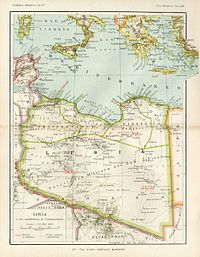Marble Arch (Libya)

The Marble Arch, also Arch of the Philaeni (Italian: Arco dei Fileni), formerly known in Libya as El Gaus (i.e. "The Arch"), was a monument in Libya built during the days of Italian colonization. The arch marked the border between Tripolitania and Cyrenaica, and was located on the Via Balbia (actual Libyan Coastal Highway) near Ra's Lanuf.[1]
History
The arch was designed by architect Florestano Di Fausto in response to a request by the Italian Governor-General Italo Balbo. It was unveiled on 16 March 1937 in a lavish night ceremony attended by Benito Mussolini.
The arch, which was 31 meters high, with an opening 15.75 meters (51 feet 8 inches) high and 6.5 meters (21 feet 4 inches) wide, and made with travertine stone (Rome's typical building material), was located some 30 km (19 mi) west of the possible borders between Carthage and Cyrene, the locality called in Antiquity Altars of the Philaeni (Latin: Arae Philaenorum) which was located approximately halfway between Ra's Lanuf and El Agheila.[1]

The landmark was named after the legendary Philaeni brothers of Carthage, who chose to be buried alive on that spot in order to gain this border for their home town. It bore two giant bronze statues of the brothers, represented as buried alive, surmounted by a stylised altar, mocking one of the disappeared Arae. The landmark was decorated by basreliefs which illustrated the legend.
On the arch's frontispiece was carved a Latin inscription taken from Horace's Carmen Saeculare. It read:
Alme Sol, possis nihil urbe Roma visere maius (which translates to: "Kind Sun, may you never look upon a city greater than Rome")
King Idris I of Libya had the Latin inscription translated into Arabic. The arch was reproduced in postcards and Italian Africa lottery tickets and soon became one of the symbols of Italian Libya and of the works done by the Italian Libyan colonists.
Revolutionary leader Muammar Gaddafi, who considered the landmark as a sign of the Italian domination of Libya, demolished the arch using dynamite in 1973. Another possible reason for this demolition is that the arch was a symbol of separation between two parts of Libya, Tripolitania and Cyrenaica. The two bronze statues of the Philaeni brothers and parts of the marble reliefs are now located in a small museum in Medinat Sultan, around 50 kilometres (31 mi) from Sirte.
See also
Notes
- ^ a b Culture clash:A tale of two libyas (Cached copy) Archived 2014-01-07 at the Wayback Machine.
References
- Philip Kenrick. Tripolitania: Libya Archaeological Guides. Silphium Press, London, 2009. 224 pages. pp. 152–157.
- The Conquest of North Africa 1940 to 1943, p. 352, at Google Books
- Libya handbook: the travel guide, p. 135, at Google Books
- Combat reporter: Don Whitehead's World War II diary and memoirs, p. 80, at Google Books
- George MacDonald Fraser, McAuslan in the Rough, Barrie & Jenkins, Ltd., 1974. pp. 16-20.

